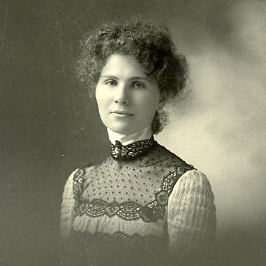
By Sally T. Grant, granddaughter of Sadie Jacobs Crockin
Listen to Sally T. Grant reading this biography via Ballots & Beyond podcast, a project of Preservation Maryland
Baltimore-born first generation Jewish teacher, activist, suffragist and visionary
Sadie Jacobs Crockin was born in Baltimore, Maryland in 1879, the eldest of 10 children. Her family moved to Lynchburg, Virginia, where she graduated public high school, then attended Randolph Macon Women’s College. Crockin graduated first in her class, winning the Oratory Medal. This talent would do well for her as she entered a career in civic engagement.
When she married Emil Crockin, she returned to Baltimore, where her daughter, Fried was born in 1905. Like most college-educated women of her day, Crockin joined clubs that pursued social, educational, religious, civic and philanthropic interests. But her passion was the “women’s suffrage” movement.
By 1911, Crockin was deeply engaged in the Maryland Equal Suffrage League. Working with Madeleine Ellicott, president of the League, they set their sights on gaining the ballot box for all women. Educating women was her mission, and soon she became Secretary and Chair of Education for the League.
That same year, Crockin was elected recording secretary of the National Council of Jewish Women’s Baltimore Section, and chaired the Immigrant Aid Committee. Later she organized and became the first president of Hadassah’s Baltimore chapter, a position she held for 13 years.
And yet, Crockin added even more to her list of activist duties, as she chaired the Americanization Committees for the Equal Suffrage League, and volunteered with the Maryland Council on Defense’s Female Section — a home front support agency during World War I.
Two years later, Crockin became team captain for the American Red Cross Christmas Seal campaign against tuberculosis. At that time Baltimore had the highest rate of infection of any major American city.
Later, her community called upon her to become a founder and incorporator of the Baltimore Hebrew College.
The 19th Amendment to the Constitution was ratified in 1920, giving women the right to vote. Carrie Chapman Catt and Maud Wood Park launched the League of Women Voters, a nonpartisan issues-oriented organization. Inspired by a thrilling speech by Park, the League’s first president, Crockin stepped forward to lead the Baltimore chapter. At the same time her dear friend and colleague, Madeleine Ellicott volunteered to lead Maryland’s statewide group.
Crockin was at the helm of the Baltimore City League for 19 years. She threw herself into organizing programs on citizenship, domestic policy and foreign affairs. She also played host to the League of Women Voters Pan-American Conference in Baltimore. Attending delegates included the most prominent women of Central and South America.
She guided the local league advocacy efforts to allow women to serve on juries, to eliminate illiteracy in the city, and to establish a statewide system of juvenile courts.
She accepted appointments to several boards and commissions, including: the Board of City Charities overseeing the City Hospital, the advisory committee of the city’s Charter Revision Commission, and the State Commission on Roadside Control and Beautification.
Ever the activist, Crockin also became a member of the Women’s International League for Peace and Freedom, the Women’s Civic League and the Women’s City Club.
American-Born Sadie Jacobs Crockin, whose father and husband were both Jewish immigrants, moved easily between different societies and people of all backgrounds. As Jews entered the mainstream, she was able to bring multicultural groups together for mutual benefit, before her death in 1965.
Her life inspired several of her descendants in promoting social justice. Her granddaughter chaired the Maryland Commission for Women and is a past president of the American Civil Liberties Union of Maryland. Her great, great granddaughter, Julia Baez, is executive director of Baltimore’s Promise, and her great-great-great-granddaughter, Olivia Baez, served on her school’s student congress.

